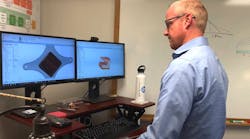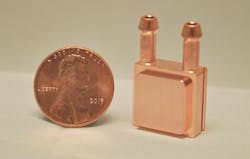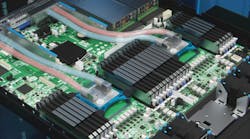High-power lasers, cell phones that record 3-D videos and computing systems with enough processing power to map the human genome are hot technologies that need to be kept cool. Without effective heat management, cutting-edge electronics melt into pools of solder and silicon.
Mikros Technologies, a manufacturer that specializes in cold plates, high-performance liquid cooling systems for computing applications, lasers and optics, keeps things chill. Their No. 1 tool for dissipating surface-of-the-sun heat intensities? Design for Manufacturing.
Design for manufacturing (DFM), optimizing product design for manufacturing processes, creates efficiency, decreases error rates and increases profitability in any manufacturing sector. In the high-tech world, lack of DFM doesn’t just negatively affect the bottom line. It could outright kill the business.
Share Your Opinions on Manufacturing Technology
IndustryWeek is in the midst of our annual technology survey. We'd love to hear your thoughts on how well technology suppliers are supporting manufacturing and what's working (and not working) with your tech investments. People who complete the survey will enter a drawing for one of two $50 Amazon gift cards. Please take some time and share your thoughts.
“I think we’ve made one that was 4mm by 6mm. So maybe about a quarter of the size of your pinky fingernail. … It actually cooled heat flux or heat-per-unit area that is more than the surface of the sun,” says Drew Matter, Vice President at Mikros Technologies.
Mikros manufactures up to 50 different types of parts per year and develops as many as 10 new designs per quarter, some for research and others for production. The most complex designs, often highly optimized for specific silicon chips, incorporate electronics, thermal controls and fluid controls. It’s a high-tech, high-mix, low-yield and extremely low-tolerance-for-error shop that requires successful DFM principles to operate successfully.
DFM Isn’t About Conflicting Priorities
While Mikros tries to skew towards design modularity, the physical components designed for cold plate designs rarely transfer from one project to another. When a new iPhone comes out every 12-to-18 months and servers and chips evolve just as quickly, there’s no time to waste on designing products that present major manufacturing challenges.
“We will work on something with an engineer for a while and when it ramps, it ramps fast. … So we have to make a bunch of prototypes and if we’re not careful on the front end of DFM, doing the DFM along the way is a lot harder,” says Matter.
DFM discussions often refer to conflicting priorities between designers and engineers. Matter says that engineers in his industry also serve as designers. The majority of Mikros products sit inside a server rack or computer, so making products look pretty isn’t a priority. An almost-zero tolerance for error focuses the company’s DFM processes on desired performance versus practical manufacturability.
“If you’re putting liquid in your system, you need to make sure that it’s leak tight. We test 100% of our liquid cold plates with helium mass spectrometry. If a helium atom can’t get out then a water droplet’s definitely not getting out,” says Matter.
Engineers can dream up designs with very high heat transfer effectiveness but the challenge of joining components on those plates may cause low yield. Trying new designs and ignoring tried-and-true means of configuring parts often doesn’t yield dividends. It’s up to veteran engineers to educate new members of the team to avoid wasting time making designs that aren’t manufacturable.
“Every time you spin up a new project, whether it goes to production or not, you end up learning a lot of things. What works, what didn’t work. And one of the things that we have tried to be diligent about over the years is rolling those lessons learned from one project into another,” says manufacturing engineering manager Adam Sharp.
Company Culture Informs DFM Success
Matter says the success of Mikros’ DFM process rides in part on a company ethos of open discussion from all relevant stakeholders, regardless of seniority or specific role.
“When you have manufacturing folks and engineers in the room, does everybody get an equal say at the table? Does a machinist feel like they have the freedom to raise their hand to the lead engineer and go, ‘That won’t work?’ Or, is there a vibe in your company where nobody questions the lead design engineer? That can actually hurt you,” says Matter.
“Lean manufacturing would tell you everybody gets to press the stop button if there’s an issue on the line and that goes for the design process, too,” Matter adds. “If you have a valuable point from the entry-level machinist, they may actually know something that’s going to save you millions of dollars and you better be willing to hear it at the table.”
One also often finds engineers on the shop floor, identifying problems and designing solutions in tandem with the machinists. Engendering this level of cooperation creates truly open and beneficial DFM discussions.
Give Supply Chain a Seat at the Table
Designers, engineers and machinists obviously require seats at the table during early DFM discussions. Including the customers footing the bill in those initial conversations may not seem intuitive but history taught Mikros the wisdom of doing so. It’s all well and good to design a part to meet high tolerances given by a customer, but a part too expensive to produce can lead to losing the business.
“We actually had one supply chain group tell [their] engineers to go find another supplier, and the supplier made an inferior cold plate that didn’t perform to the specs that we were told. Then the supply chain people said that those [lesser] specs were okay, even though they’re not engineers, and then approved that other vendor so that they could show that they saved the company money,” Matter says.
As a result of that experience, Mikros now brings a customer’s supply chain people into the room for the earliest discussions with thermal engineers. Price becomes another design variable and the customer has to give a discrete answer before the design process moves forward.
DFM Stories from Other Endeavor Business Media Publications
- 6 Best Practices for a Smoother PCB Assembly Process, Electronic Design
- Using Injection Molding to Design a “Smart” Wheelchair Fit for Family, Machine Design
- 5 Ways to Strengthen Your Supply Chains, New Equipment Digest
Team ethos addresses concerns about non-engineers informing engineering decisions and keeps everyone focused on the goal of getting the business. One also should consider an engineer’s basic nature, Matter says. Cost presents another challenge to overcome and defeating design constraints makes an engineer happy.
“The addition of cost as a design variable at the beginning of the process really helps the design and manufacturing teams know which direction they need to go. Previously, a lot of the time we would get projects that just had to hit some performance goal and it was kind of nebulous. You can achieve that in many different ways and for many different cost levels. Being able to have a target that is set by the customer is really beneficial, to be able to drive some of those decisions down the line,” says Sharp.
“If low cost is a decision it actually can drive simplicity into the design. And simplicity in engineering design is usually a very good thing,” adds Matter.
DFM for Happiness
Matter says that happiness, not profitability or efficiency, is the greatest benefit of a rigorous DFM process, even if that sounds strange (especially to a CFO).
Operators like going home with a sense of success. Engineers and designers can make operators’ lives hard and terrible or fun and productive. No one likes throwing away 950 of 1,000 parts during a shift because the parts were too persnickety to manufacture. .
“That affects an organization. And you can even [still] be profitable and you still don’t want that larger effect on the organization because that’s an intangible that’s going to make you less profitable and your management is not going to know why. There’s going to be more people calling in sick, right?
“If you can actually make things that perform well, that are easy to make, then people are proud of what they do. And if you’re proud of your work, you get up and come to work in the morning and do it better. You want to contribute to the conversation. So I think DFM has a real opportunity to impact an organization in both tangible profitability and intangible workforce happiness,” says Matter.
About the Author
Dennis Scimeca
Dennis Scimeca is a veteran technology journalist with particular experience in vision system technology, machine learning/artificial intelligence, and augmented/mixed/virtual reality (XR), with bylines in consumer, developer, and B2B outlets.
At IndustryWeek, he covers the competitive advantages gained by manufacturers that deploy proven technologies. If you would like to share your story with IndustryWeek, please contact Dennis at [email protected].




